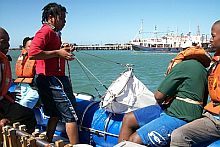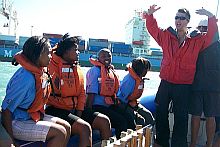Introducing rural “bright sparks” to coastal and marine science
|
The Education Outreach unit of the SAEON Elwandle Node, in partnership with the South African Institute for Aquatic Biodiversity (SAIAB) organised the Bright Sparks Science Camp which was held in Port Elizabeth during April.
The four-day camp formed part of a programme to address the critical shortage of black marine scientists in the country, and was sponsored by construction and engineering group Murray & Roberts.
The group of thirty learners was made up of the top science scholars from disadvantaged rural schools in the Eastern Cape. In the theoretical session, the learners got to know more about environmental science observations and monitoring techniques, examples of school-based environmental monitoring projects and the importance of long-term environmental monitoring.
Two of SAEON’s postgraduate students, Luzuko Dali and Ntuthuko Masikane introduced the learners to their own monitoring projects at Nelson Mandela Bay and the types of methods they use to conduct their research. Both presentations emphasised the importance of marine biology as a career, and the subjects required to enrol for such a degree.
The presentations were interactive and met with an overwhelming response on the part of the learners, particularly where presenters used examples of terrestrial ecosystems familiar to the learners. The enthusiastic youngsters were also exposed to case studies on the benthic (or seabed) ecology and plankton ecology of the Bay.
Engaging in field practice …
Following their introduction to theory, the learners were given the opportunity to gain hands-on experience in field activities. These included sampling the harbour waters in Nelson Mandela Bay using a small boat. The excursion exposed the learners to the practical side of marine science and they made full use of the opportunity to get to grips with the sampling equipment. Luzuko and Ntuthuko showed them how to use a “grab” on the end of a rope to scoop up material from the seabed, and to harvest plankton from the water column by using a fine-meshed net.
… and field trips
They were then taken to Bayworld Aquarium to view the aquatic animals, and to learn more about the methods and practices used to monitor the health of animals living under human care. A dolphin and seal performance was the undoubted highlight of the visit.
The learners were also taken on a tour of the South African Weather Service (SAWS) to expose them to different weather phenomena being observed and monitored, and methods for data collection and interpretation. They also got to learn more about the different careers options at the SAWS.
What the learners had to say
“I learnt that even if there are difficulties and challenges, if I have a passion and determination in the science field I will succeed.” - Phumla Mayekiso
“I came back from the camp motivated, educated and determined to work 12 times harder.” - Xolisani Brakfesi














